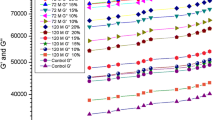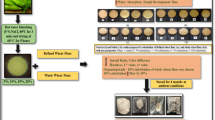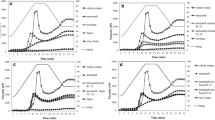Abstract
Pinto beans were milled and then air-classified to obtain a raw high protein fraction (RHPF) followed by extrusion to texturize the protein fraction. The texturized high protein fraction (THPF) was then milled to obtain flour, and combined with wheat flour at 5, 10, and 15 % levels to make bread. The air-classification process produced flour with high concentration of lipids and phytic acid in the protein-rich fraction. However, extrusion significantly reduced hexane extractable lipid and phytic acid. However, the reduction observed may simply indicate a reduction in recovery due to bind with other components. Total protein and lysine contents in composite flours increased significantly as THPF levels increased in composite flour. Bread made with 5 % THPF had 48 % more lysine than the 100 % wheat flour (control). The THPF helped to maintain dough strength by reducing mixing tolerance index (MTI), maintaining dough stability and increasing departure time on Farinograph. Bread loaf volume was significantly reduced above 5 % THPF addition. THPF increased water absorption causing an increase in bread weights by up to 6 %. Overall, loaf quality deteriorated at 10 and 15 % THPF levels while bread with 5 % THPF was not significantly different from the control. These results support the addition of 5 % THPF as a means to enhance lysine content of white pan bread.

Similar content being viewed by others
Abbreviations
- AAA:
-
Amino acid analyzer
- RHPF:
-
Raw high protein fraction
- THPF:
-
Texturized high protein fraction
- WAI:
-
Water absorption index
- WSI:
-
Water solubility index
- MTI:
-
Mixing tolerance index
References
Duranti M (2006) Grain legume proteins and nutraceutical properties. Fitoterapia 77:67–82
Lorimer NL, Zabik ME, Harte JB, Stachiw NC, Uebersax MA (1991) Effect of navy bean protein flour and navy bean globulin(s) on composite flour rheology, chemical bonding, and microstructure. Cereal Chem 68:213–220
Czarnecki Z, Khan K, Gujska E (1993) Extrusion of pinto bean high protein fraction pretreated with papain and cellulase enzymes. J Food Sci 58:395–398
Fenn D, Lukow OM, Humphreys G, Fields PG, Boye JI (2010) Wheat-legume composite flour quality. Int J Food Prop 13:381–393
Schutyser MAI, Goot AJ (2011) The potential of dry fractionation processes for sustainable plant protein production. Trends Food Sci Technol 22:154–164
Fleming SE, Sosulski FW (1977) Breadmaking properties of four concentrated plant proteins. Cereal Chem 54:1124–1140
Fleming SE, Sosulski FW (1978) Microscopic evaluation of bread fortified with concentrated plant proteins. Cereal Chem 55:373–382
Deshpande S, Salunkhe D, Sathe S, Rangnekar P (1983) Functional properties of wheat-bean composite flours. J Food Sci 48:1659–1662
Silaula SM, Lorimer NL, Zabik ME, Uebersax MA (1989) Rheological and sensory characteristics of bread flour and whole wheat flour doughs and breads containing dry-roasted air-classified pinto and navy bean high-protein fractions. Cereal Chem 66:486–490
KeShun L, Fu-Hung H (2007) Protein-protein interactions in high moisture extruded meat analogs and heat-induced soy protein gels. J Am Oil Chem Soc 84:741–748
KeShun L, Fu-Hung H (2008) Protein-protein interactions during high-moisture extrusion for fibrous meat analogues and comparison of protein solubility methods using different solvent systems. J Agric Food Chem 56:2681–2687
Simons C, Hall C, Tulbek M (2012) Effects of extruder screw speeds on physical properties and in vitro starch hydrolysis of precooked pinto, navy, red, and black bean extrudates. Cereal Chem 89(3):176–181
AACC International (2011) Approved methods of the AACC, 11th edn. St Paul, MN
Moore SD, Spackman H, Stein WH (1958) Chromatography of amino acids on sulfonate polystyrene resins; and improved system. Anal Chem 30:1185–1190
Ozols J (1990) Amino acid analysis. In: Deutscher MP (ed) Methods in enzymology. Academic, San Diego, pp 587–601
Cooper C, Packer N, Williams K (2000) Methods in molecular biology: amino acid analysis protocols. Humana Press, New Jersey
AOCS (1998) Official methods and recommended practices of the AOCS. American Oil Chemists Society Champaign, IL
Anderson RA (1982) Water absorption and solubility and amylograph characteristics of roll-cooked small grain products. Cereal Chem 59:265–269
Gujska E, Khan K (1991) High temperature extrusion effects on protein solubility and distribution in navy and pinto beans. J Food Sci 56:1013–1016
Yoon JH, Jenkins DJA, Thompson LU (1983) The effect of phytic acid on in vitro rate of starch digestibility and blood glucose response. Am J Clin Nutr 38:835–842
Jenab M, Thompson LU (1998) The influence of phytic acid in wheat bran on early biomarkers of colon carcinogenesis. Carcinogenesis 19:1087–1092
Izzo MT, Ho CT (1989) Protein-lipid interaction during single-screw extrusion of zein and corn oil. Cereal Chem 66:47–51
Bhatnagar S, Hanna MA (1994) Extrusion processing conditions for amylose-lipid complexing. Cereal Chem 71:587–593
Kasprzak M, Rzedzicki Z (2012) Application of grasspea wholemeal in the technology of white bread production. Pol J Food Nutr Sci 62:207–213
Cai L, Choi I, Hyun J-N, Jeong Y-K, Baik B-K (2014) Influence of bran particle size on bread-baking quality of whole grain wheat flour and starch retrogradation. Cereal Chem 91:65–71
Zhang D, Moore W (1997) Effect of wheat bran particle size on dough rheological properties. J Sci Food Agric 74:490–496
Zhang D, Moore W (1999) Wheat bran particle size effects on bread baking performance and quality. J Sci Food Agric 79:805–809
Swanson R (2004) Bakery: yeast-leavened breads. In: Smith SJ, Hui YH (eds) Food processing principles and applications. Wiley- Blackwell, Ames, IA, pp 183–202
Acknowledgments
We express our thanks to Northarvest Bean Growers Association for research funding, Kristin Whitney and DeLane Olsen for providing technical assistance during dough analysis and bread baking and Rilie Morgan from the Northern Crops Institute for technical assistance during extrusion.
Conflict of Interest
The authors claim no conflict of interest. This article does not contain any studies with human or animal subjects.
Author information
Authors and Affiliations
Corresponding author
Rights and permissions
About this article
Cite this article
Simons, C.W., Hunt-Schmidt, E., Simsek, S. et al. Texturized Pinto Bean Protein Fortification in Straight Dough Bread Formulation. Plant Foods Hum Nutr 69, 235–240 (2014). https://doi.org/10.1007/s11130-014-0421-1
Published:
Issue Date:
DOI: https://doi.org/10.1007/s11130-014-0421-1




